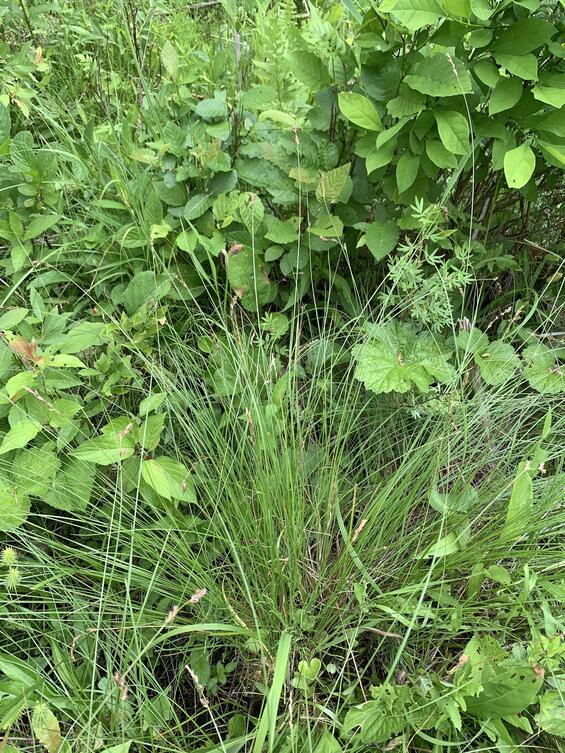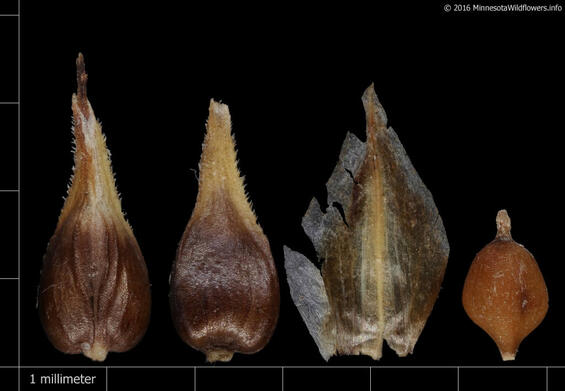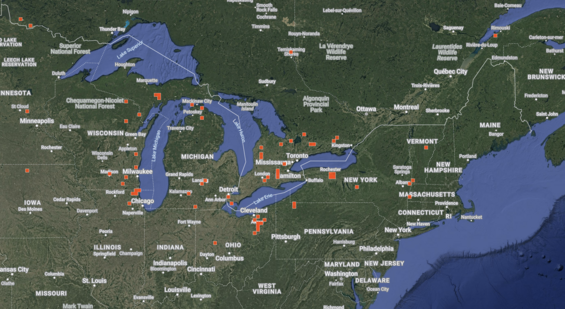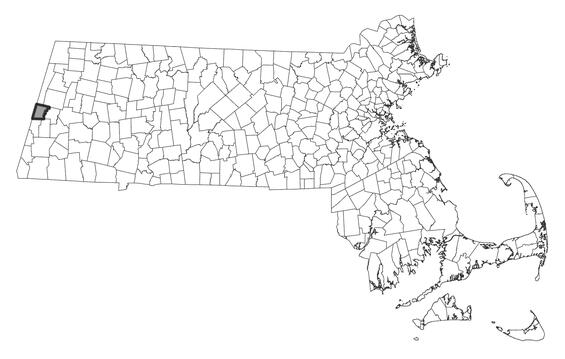- Scientific name: Carex prairea Wahlenb.
Species of Greatest Conservation Need (MA State Wildlife Action Plan)
Description

A large tussock of prairie-sedge rising vertically above the wetland soil. Photo by Peter P. Grima
Prairie-sedge is a grass-like plant in the genus Carex, the most species-rich genus in Massachusetts, with 180 taxa throughout the northeastern states (Bennett 1996, Cullina et al. 2011). Technical skills and a detailed dichotomous key are needed for proper identification of this group of plants.
Leaf sheaths are a common and often determinative feature of sedges. In most grasses, where the leaf joins the stem, the edge of the leaf wraps around the stem, but in sedges, it forms a closed sheath. In this species, the sheaths are distinctly copper-colored at the top and extend as high as 8 mm (0.3 in) above the leaf blade connection.
Prairie-sedge has flowers that measure up to 6 cm (2.4 in) in height and elongating up to 1 meter (39.4 in) in fruit. The leaf blades are up to 50 cm (20 in) long and less than 3 mm (0.1 in) wide. The flower clusters are both male and female, or nearly unisexual, and spread out along the main axis of the flowering head. The flower or fruiting head is flexible (not stiff). Pistillate scales are light reddish brown and cover the perigynia. The perigynia are straw colored, light or dark brown, strongly 6-9-veined abaxially, lance-ovate in shape, and up to 3 mm (0.1 in) in length. (Cochrane 2020)

Comparison of the perigynia of look-alike species. Prairie-sedge on the left and panicled sedge on the right. ©MinnesotaWildflowers.info. Used by permission.

Perigynia, pistillate scale and achene ©MinnesotaWildflowers.info. Used by permission
Long extended sheath with coppery color at the top. Photo by Peter P. Grima
Life cycle and behavior
Prairie-sedge is a perennial and generally flowers every year. It is wind-pollinated.

Carex prairea flowers can appear in the last week of May and begin setting fruit by June 1, retaining fruit for the remainder of June and the first week of July.
Population status
Prairie-sedge has been tracked by MassWildlife’s Natural Heritage and Endangered Species Program as a watch-list species since 1988 and has 3 records since that time. As of 17 Feb 2025, iNaturalist has only 2 research-grade observations for this species. All five of these records occur in Berkshire County. Even when in fruit, the species is easily overlooked, lacks features that readily stand out, and is often with other similar sedge species, so we can assume that more populations are likely to be discovered.

Map of research-grade observations of Carex prairea in eastern North America screen-captured from iNaturalist.org on 26 February 2025.
Distribution and abundance
Prairie-sedge is a widespread species across northern latitudes in North America (POWO 2025), ranging from Virginia to Nova Scotia in the east, where it is extremely rare, westward to British Columbia and the Yukon Territory. It is more common in the limestone areas of the Upper Midwest. In New England, it is ranked S3 (vulnerable) in Vermont, unranked in New Hampshire and Rhode Island, S2 in Connecticut and S1(critically imperiled) in Maine and Massachusetts (NatureServe 2025). The plant has been found in Berkshire, Essex, Hampden, Middlesex, and Nantucket counties (CNH 2025, Cullina et al. 2011).

Distribution in Massachusetts
1999-2024
Based on records in the Natural Heritage Database
Habitat
Prairie-sedge is an obligate wetland species that occurs typically in sun or partial shade in swamps, bogs, marshes, pond shores and wet meadows, with some records that are dated to 1911 on Nantucket that appear to be from a salt marsh with freshwater input (Omand, pers. Comm. 2025). It is a known calciphile, so its occurrence typically indicates calcium-rich moisture in the soil. Associated native species in one location include other sedge species Carex comosa, C. flava, C. lurida, C. stricta, as well as Lobelia kalmii (Kalm’s lobelia), Lysimachia terrestris (swamp candles), Lysimachia thyrsiflora (tufted loosestrife), Poa palustris (marsh bluegrass), Salix candida (sage willow) and Typha latifolia (broad-leaved cattail). Associates in a second location include: Eriophorum viridicarinatum (green-keeled cottongrass), Solidago patula (rough-leaved goldenrod), Rhamnus alnifolia (alder-leaved buckthorn), Sphenopholis intermedia (slender wedge grass), Carex interior (inland sedge), Geum rivale (water avens), Salix spp. (willow), Dasiphora floribunda (shrubby cinquefoil), and Parnassia glauca (grass of Parnassus; Grima, pers. comm., 2025).
Healthy habitats are vital for supporting native wildlife and plants. Explore habitats and learn about conservation and restoration in Massachusetts.
Threats
Prairie-sedge is threatened by succession when open wetlands become overgrown with shrubs and trees, and by problematic invasive species such as glossy buckthorn (Frangula alnus), purple loosestrife (Lythrum salicaria), reed canary grass (Phalaris arundinacea) and giant reed grass (Phragmites australis) which can all grow quickly and thickly, shading and crowding out the sedges. Disruption of the natural hydrologic regime is also a threat. Beaver dams causing significant water level increases in wetland basins can also create unfavorable conditions for this species. This being a species of more northerly distribution, climate warming is a potential threat. The past 130 years have seen a warming of 1.4 °C (2.5 °F) in the northeast United States (Staudinger et al. 2024). Northern species can be expected to move much farther north in an attempt to occupy a habitat within their evolved climate envelope.
Conservation
Survey and monitoring
Given these are hardy perennial species, monitoring could be done on a five-year cycle in June with estimates of plant vigor and seed production and including a threat assessment. Special emphasis should be made to target known sites that are 20 or more years overdue for survey and monitoring.
Management
An important aspect to management of wetlands is to remove and reduce populations of all invasive species, especially those mentioned in the threat section. In some areas brush and shrub removal may be needed. This is typically done in winter on frozen ground. Another aspect for this species will be to watch for altered water levels from beaver activity, development, ditches, or road building.
Research needs
As this plant is under-surveyed, a serious effort should be made to conduct de novo surveys in areas where this is likely to occur or where records are over 100 years old. Additionally, standard information is needed such as lists of associated species, comments on habitat quality and threats, assessments of water levels and chemistry, and phenology. Research is needed to determine whether this plant can be grown in a nursery or garden setting for purposes of reintroductions. If habitat degradation accelerates losses of current populations, this strategy could prove useful to long-term conservation of this species.
References
Arsenault Matt, Glen H. Mittelhauser, Don Cameron, Alison C. Dibble, Arthur Haines, Sally C. Rooney, and Jill E. Weber. 2013. Sedges of Maine: A Field Guide to Cyperaceae. University of Maine Press, Orono, ME. 712 pp.
Bennett, J. P. 1996. Floristic summary of Manual of Vascular Plants of Northeastern United States and Adjacent Canada, second edition. The Botanical Review 62: 203–206.
Bertin, R. I., M. G. Hickler, K. B. Searcy, G. Motzkin, and P. P. Grima. 2020. Vascular Flora of Franklin County, Massachusetts. New England Botanical Club.
CNH 2025 Consortium of Northeastern Herbaria web site, www.neherbaria.org, accessed 25 Feb 2025.
Cochrane, T. S. Carex prairea Dewey. Page version 5 November 2020 In: Flora of North America Editorial Committee, eds. 1993+. Flora of North America North of Mexico [Online]. 25+ vols. New York and Oxford. Vol. 23. Website http://floranorthamerica.org/Carex_prairea [accessed 21 February 2025].
Cullina, M., B. Connolly, B. Sorrie, and P. Somers. 2011. The vascular plants of Massachusetts: a county checklist, 1st revision. Massachusetts Natural Heritage & Endangered Species. Massachusetts Division of Fisheries and Wildlife, Westborough, MA.
Fernald, M. L. 1950. Gray’s Manual of Botany, Eighth (Centennial) Edition—Illustrated. American Book Company, New York.
Gleason, Henry A., and Arthur Cronquist. Manual of Vascular Plants of Northeastern United States and Adjacent Canada, Second Edition. Bronx, NY: The New York Botanical Garden, 1991.
Grima, Peter P. 2025. Personal communication. Email dated 26 Feb. 2025.
Haines, Arthur. Flora Novae Angliae. New England Wild Flower Society, Yale University Press, New Haven, CT. 2011.
Hipp, A. 2008. Field guide to Wisconsin sedges: An introduction to the genus Carex (Cyperaceae). Univ of Wisconsin Press.
iNaturalist. Available from https://www.inaturalist.org. Accessed 25 February 2025
Native Plant Trust. 2025. Go Botany website. https://gobotany.nativeplanttrust.org/ Accessed 2/17/2025
NatureServe. 2025. NatureServe Network Biodiversity Location Data accessed through NatureServe Explorer [web application]. NatureServe, Arlington, Virginia. Available https://explorer.natureserve.org/. Accessed: 2/25/2025
Omand, Kelly. 2025. Botanist with Nantucket Conservation Foundation and co-author of a forthcoming Nantucket Flora. Personal communication on 25 February 2025.
POWO (2025). "Plants of the World Online. Facilitated by the Royal Botanic Gardens, Kew. Published on the Internet; https://powo.science.kew.org/ Retrieved 25 February 2025."
Staudinger, M.D., A.V. Karmalkar, K. Terwilliger, K. Burgio, A. Lubeck, H. Higgins, T. Rice, T.L. Morelli, A. D'Amato. 2024. A regional synthesis of climate data to inform the 2025 State Wildlife Action Plans in the Northeast U.S. DOI Northeast Climate Adaptation Science Center Cooperator Report. 406 p. https://doi.org/10.21429/t352-9q86
Contact
| Date published: | March 26, 2025 |
|---|